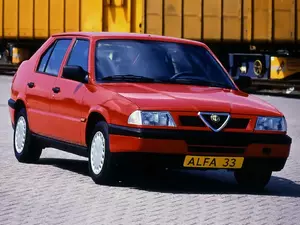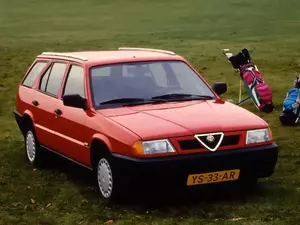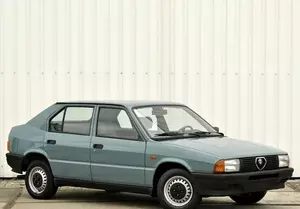
| Vehicle | Precise engine size | Difference from world average | Engine size to consumption ratio | Horsepower from 1 L | Engine size to 100 kg of weight |
|---|---|---|---|---|---|
| 1.4 i.e. |
1.35 L (1351 cc) |
42.4% smaller | 45 cc to 1 mpg | 67 hp from 1 L | 150 cc to 100 kg |
| 1.5 |
1.49 L (1490 cc) |
36.5% smaller | 51 cc to 1 mpg | 65 hp from 1 L | - |
| 1.7 16V |
1.71 L (1712 cc) |
27% smaller | 57 cc to 1 mpg | 77 hp from 1 L | 171 cc to 100 kg |
| 1.7 16V 4x4 |
1.71 L (1712 cc) |
27% smaller | - | 77 hp from 1 L | 156 cc to 100 kg |
| 1.7 i.e. |
1.71 L (1712 cc) |
27% smaller | 55 cc to 1 mpg | 63 hp from 1 L | 171 cc to 100 kg |
| 1.8 TD |
1.78 L (1779 cc) |
24.2% smaller | 52 cc to 1 mpg | 47 hp from 1 L | 178 cc to 100 kg |
| 1.7 i.e. 4x4 |
1.71 L (1712 cc) |
27% smaller | 55 cc to 1 mpg | 63 hp from 1 L | 171 cc to 100 kg |
| Vehicle | 1.4 i.e. |
|---|---|
| Precise engine size | 1.35 L (1351 cc) |
| Difference from world average | 42.4 smaller |
| Engine size to consumption ratio | 45 cc to 1 mpg |
| Horsepower from 1 L | 67 hp from 1 L |
| Engine size to 100 kg of weight | 150 cc to 100 kg |
| Vehicle | 1.5 |
| Precise engine size | 1.49 L (1490 cc) |
| Difference from world average | 36.5 smaller |
| Engine size to consumption ratio | 51 cc to 1 mpg |
| Horsepower from 1 L | 65 hp from 1 L |
| Engine size to 100 kg of weight | - |
| Vehicle | 1.7 16V |
| Precise engine size | 1.71 L (1712 cc) |
| Difference from world average | 27 smaller |
| Engine size to consumption ratio | 57 cc to 1 mpg |
| Horsepower from 1 L | 77 hp from 1 L |
| Engine size to 100 kg of weight | 171 cc to 100 kg |
| Vehicle | 1.7 16V 4x4 |
| Precise engine size | 1.71 L (1712 cc) |
| Difference from world average | 27 smaller |
| Engine size to consumption ratio | - |
| Horsepower from 1 L | 77 hp from 1 L |
| Engine size to 100 kg of weight | 156 cc to 100 kg |
| Vehicle | 1.7 i.e. |
| Precise engine size | 1.71 L (1712 cc) |
| Difference from world average | 27 smaller |
| Engine size to consumption ratio | 55 cc to 1 mpg |
| Horsepower from 1 L | 63 hp from 1 L |
| Engine size to 100 kg of weight | 171 cc to 100 kg |
| Vehicle | 1.8 TD |
| Precise engine size | 1.78 L (1779 cc) |
| Difference from world average | 24.2 smaller |
| Engine size to consumption ratio | 52 cc to 1 mpg |
| Horsepower from 1 L | 47 hp from 1 L |
| Engine size to 100 kg of weight | 178 cc to 100 kg |
| Vehicle | 1.7 i.e. 4x4 |
| Precise engine size | 1.71 L (1712 cc) |
| Difference from world average | 27 smaller |
| Engine size to consumption ratio | 55 cc to 1 mpg |
| Horsepower from 1 L | 63 hp from 1 L |
| Engine size to 100 kg of weight | 171 cc to 100 kg |

| Vehicle | Precise engine size | Difference from world average | Engine size to consumption ratio | Horsepower from 1 L | Engine size to 100 kg of weight |
|---|---|---|---|---|---|
| 1.4 i.e. |
1.35 L (1351 cc) |
42.4% smaller | 44 cc to 1 mpg | 67 hp from 1 L | 135 cc to 100 kg |
| 1.4 i.e. 4x4 |
1.35 L (1351 cc) |
42.4% smaller | 48 cc to 1 mpg | 67 hp from 1 L | 135 cc to 100 kg |
| 1.5 i.e |
1.49 L (1490 cc) |
36.5% smaller | 50 cc to 1 mpg | 65 hp from 1 L | 149 cc to 100 kg |
| 1.7 16V |
1.71 L (1712 cc) |
27% smaller | - | 77 hp from 1 L | 171 cc to 100 kg |
| 1.7 16V 4x4 |
1.71 L (1712 cc) |
27% smaller | - | 77 hp from 1 L | 156 cc to 100 kg |
| 1.7 i.e. |
1.71 L (1712 cc) |
27% smaller | - | 63 hp from 1 L | 171 cc to 100 kg |
| 1.8 TD |
1.78 L (1779 cc) |
24.2% smaller | 51 cc to 1 mpg | 47 hp from 1 L | 162 cc to 100 kg |
| 1.7 i.e. 4x4 |
1.71 L (1712 cc) |
27% smaller | 55 cc to 1 mpg | 63 hp from 1 L | 171 cc to 100 kg |
| Vehicle | 1.4 i.e. |
|---|---|
| Precise engine size | 1.35 L (1351 cc) |
| Difference from world average | 42.4 smaller |
| Engine size to consumption ratio | 44 cc to 1 mpg |
| Horsepower from 1 L | 67 hp from 1 L |
| Engine size to 100 kg of weight | 135 cc to 100 kg |
| Vehicle | 1.4 i.e. 4x4 |
| Precise engine size | 1.35 L (1351 cc) |
| Difference from world average | 42.4 smaller |
| Engine size to consumption ratio | 48 cc to 1 mpg |
| Horsepower from 1 L | 67 hp from 1 L |
| Engine size to 100 kg of weight | 135 cc to 100 kg |
| Vehicle | 1.5 i.e |
| Precise engine size | 1.49 L (1490 cc) |
| Difference from world average | 36.5 smaller |
| Engine size to consumption ratio | 50 cc to 1 mpg |
| Horsepower from 1 L | 65 hp from 1 L |
| Engine size to 100 kg of weight | 149 cc to 100 kg |
| Vehicle | 1.7 16V |
| Precise engine size | 1.71 L (1712 cc) |
| Difference from world average | 27 smaller |
| Engine size to consumption ratio | - |
| Horsepower from 1 L | 77 hp from 1 L |
| Engine size to 100 kg of weight | 171 cc to 100 kg |
| Vehicle | 1.7 16V 4x4 |
| Precise engine size | 1.71 L (1712 cc) |
| Difference from world average | 27 smaller |
| Engine size to consumption ratio | - |
| Horsepower from 1 L | 77 hp from 1 L |
| Engine size to 100 kg of weight | 156 cc to 100 kg |
| Vehicle | 1.7 i.e. |
| Precise engine size | 1.71 L (1712 cc) |
| Difference from world average | 27 smaller |
| Engine size to consumption ratio | - |
| Horsepower from 1 L | 63 hp from 1 L |
| Engine size to 100 kg of weight | 171 cc to 100 kg |
| Vehicle | 1.8 TD |
| Precise engine size | 1.78 L (1779 cc) |
| Difference from world average | 24.2 smaller |
| Engine size to consumption ratio | 51 cc to 1 mpg |
| Horsepower from 1 L | 47 hp from 1 L |
| Engine size to 100 kg of weight | 162 cc to 100 kg |
| Vehicle | 1.7 i.e. 4x4 |
| Precise engine size | 1.71 L (1712 cc) |
| Difference from world average | 27 smaller |
| Engine size to consumption ratio | 55 cc to 1 mpg |
| Horsepower from 1 L | 63 hp from 1 L |
| Engine size to 100 kg of weight | 171 cc to 100 kg |

| Vehicle | Precise engine size | Difference from world average | Engine size to consumption ratio | Horsepower from 1 L | Engine size to 100 kg of weight |
|---|---|---|---|---|---|
| 1.7 QV |
1.7 L (1700 cc) |
27.5% smaller | - | 69 hp from 1 L | - |
| Vehicle | 1.7 QV |
|---|---|
| Precise engine size | 1.7 L (1700 cc) |
| Difference from world average | 27.5 smaller |
| Engine size to consumption ratio | - |
| Horsepower from 1 L | 69 hp from 1 L |
| Engine size to 100 kg of weight | - |